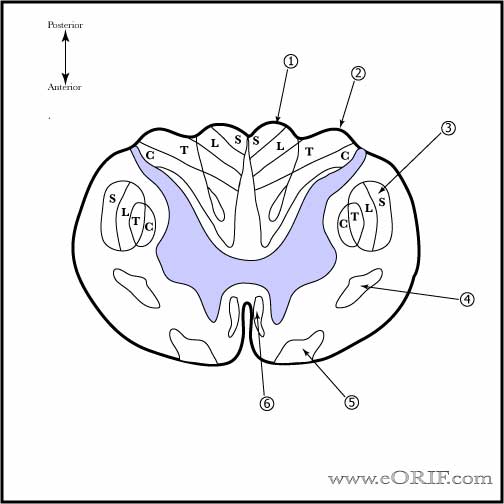|

 
|
synonyms:
Thoracolumbar Spine Trauma ICD-9
Thoracolumbar Spine Trauma Etiology / Epidemiology / Natural History
- Typically high energy trauma (MVC, falls from height) in young patients. Low-energy osteoporotic fractures in elderly patients.
- Injuries generally occur at the T12-L1 thoracolumbar junction
Thoracolumbar Spine Trauma Anatomy
- Thoracic Spine: average 35° of kyphosis
- Lumbar Spine: average 40° lordosis (primarily L4-S1).
- Spinal Cord (adult): extends from foramen magnum to L1 vertebral body.
- Blood supply to thoracic spinal cord: one anterior and two posterior spinal arteries. 10% of patients have predominant anterior radicular artery of Adamkiewicz which originates from on the of the left T8-L2 intercostal arteries.
Thoracolumbar Spine Trauma Clinical Evaluation
- Palpate entire spine for tenderness / step off.
- Complete neuro exam: motor strength, pin-prick sensation, reflexes, cranial nerves, rectal examination (perineal pin-prick sensation, sphincter tone, volitional spincter control)
- Absence of the bulbocaverosus reflex indicates spinal shock. Level of spinal injury can not be determined until bulbocaverosus reflex has returned.
- See ASIA form.
Thoracolumbar Spine Trauma Xray / Diagnositc Tests
- A/P and Lateral views of the thoracic and lumbar spine.
- CT Thoracolumbar spine: Better specificity, sensitivty and safety than screening xrays, but exposes patients to 6x more radiaiton. (Inaba K, J Trauma 2006;60:915).
- MRI: indicated for neuro deficit, suspicious of instability or HNP, pre-op evaluation. PLC injury indicated by increased signal on T2-weighted images.
Thoracolumbar Spine Trauma Classification / Treatment
- Any trauma pt with suspected spine injury should be immobilized on a spine board with Thoracolumbar collar and log-roll precautions until the c-spine has been cleared.
- Thoracolumbar Injury Classification and Severity Score (Lee JY, J Orthop Sci 2005;10:671).
- TLICSS<3: short period bedrest followed by mobilization in TLSO ro Risser-like body cast with spine in hyperextension for 10-12 weeks. See Differential Diagnosis for specific injuries / treatments.
- TLICSS <5: surgery
Thoracolumbar Spine Trauma Differential Diagnosis
- Burst Fracture
- Compression Fracture
- Spinal Cord Injury
Thoracolumbar Spine Trauma Complications
Thoracolumbar Spine Trauma Follow-up Care
Thoracolumbar Spine Trauma Review References
|



